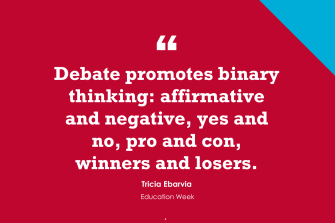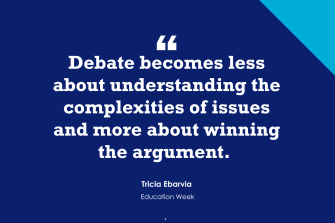This post is an excerpt from educator Tricia Ebarvia’s new book, Get Free: Antibias Literacy Instruction for Stronger Readers, Writers, and Thinkers.
You can see my interview with Tricia about the book here.
Talking ‘With’ Instead of Talking ‘Over’
Tricia Ebarvia is a lifelong educator, author, speaker, and literacy consultant.
One of the most important skills our kids can learn in school—and why teaching and learning is fundamentally human work—is how to have meaningful, authentic conversations with each other. How to disagree without being disagreeable. How to listen and not just hear. How to start from a place of curiosity rather than a place of shutting down. How to talk with instead of talk over.
It’s not easy.
While there are many reasons that make meaningful conversation difficult, sometimes it’s how we frame classroom discussion that gets in the way. And one framing in particular—debate—almost always does more to deter conversation and understanding.
And by debate, I mean any activity that frames discussion about a complex topic as a list of pros versus cons, this versus that, right versus wrong. Sometimes this framing is intentional (I’m thinking of many social studies classes), but sometimes even the most well-intentioned conversations can end up devolving into a heated either-or debate that pits students against one another.
Of course, it’s easy to see why this might happen. After all, many common library databases that students use for research often organize their articles as pro and con. Students’ mentor texts for conversation in public discourse are pundits and assorted talking heads talking past one another, whether that’s on a cable news program or sports analysis. Televised political debates are less about listening and more about making newsworthy sound bites.
While I recognize the potential value of debate, my own discomfort with it as an instructional method is the way debate promotes binary thinking: affirmative and negative, yes and no, pro and con, winners and losers. Many, if not all, of our most pressing issues facing us today cannot be reduced, much less solved, using such binary thinking. Binary thinking leads to the oversimplification of complex issues. Nuance and exceptions to the rule, which always exist, are pushed to the margins in favor of neat, simple, clear solutions, which may or may not always be correct.

Furthermore, framing discussion as debate compels students to choose sides, regardless of whether or not that “side” is defensible (or only defensible in ways that could be potentially harmful). In the best-case scenario, debate might offer students an opportunity to understand another perspective that they might not necessarily agree with. This is an essential skill to have and intentional perspective-taking is critical to taking an anti-bias stance.
But when debate is framed to force students to choose one of two opposing sides, as it almost always is, then debate becomes less about understanding the complexities of issues and more about winning the argument. And I don’t know about you, but I’ve yet to meet an adolescent who doesn’t want to win an argument (or at least not lose, especially in front of their peers).
We raise the stakes of conversations when we force students into the binary construction of debate. The goal of debate is to win. Yet developing a deeper understanding of a complex issue often requires us to lose—to seek and to acknowledge the ways in which our thinking is limited or even wrong.

So how can we do this? What shifts can we make?
- Instead of brainstorming “sides” to an argument or issue, start with the question about who cares. In other words, who would or should care about this issue? Ask students to brainstorm all the possible individuals or groups who may be directly or indirectly impacted by this issue. In my experience, asking students to see an issue from the perspective and experience of a particular individual or group requires an empathy that abstract positions about an issue do not.
- Ask students to identify the diversity and range of perspectives within any particular group of people who care about this issue. Support students with texts that help to reveal this diversity of opinions, or ask students to research on their own. A resource that might be helpful is the Spectrum series on the Jubilee YouTube channel, in which the hosts read statements to a particular group of people whose opinions vary, despite having a shared identity.
- Once students have a better understanding of how particular groups might feel about an issue, ask them to work with other students to find places where different groups might have shared and diverging interests: where can different groups agree? where do they disagree?
- Help students understand that perspectives are not fixed, that positions can change depending on the context and under differing conditions. Ask students to consider how a group’s perspective about the issue might change under different circumstances: which ones? why? and how might this change help us to better understand the issue itself?
- Finally, after considering multiple and varied viewpoints of several different groups, then ask students where they agree and disagree. Encourage students to think beyond agreeing or disagreeing with a particular group. Instead, ask which parts of a group’s position they might agree or disagree with and under what conditions. This exercise is a good example of how to help students qualify their reasoning.
To help see the complexities of an issue, I often use the example of wall paint. I bring in several different paint swatches in shades of white and gray. I ask students which swatch is the “most accurate shade of white” and “most accurate shade of gray.” Of course, students quickly see that this is impossible. What counts as white—much less what is “accurate”—depends both on the viewer and on how one shade of white compares to others. Some shades of white look more yellow or blue when compared side-by-side with others. Some shades of gray look brighter or darker depending on whether we stand close or far away.
In this same way, our understanding of an issue also depends on where we stand: both the context and our own positionality. There is no either-or, black or white, pro or con. The issues we face today require empathy, flexible thinking, and deep understanding of the complex and complicated problems we face if we can even hope to address, much less solve, them. As activist Margaret Wheatley (2009) reminds us:
We will succeed in changing this world only if we can think and work together in new ways. Curiosity is what we need. We don’t have to let go of what we believe, but we do need to be curious about what someone else believes. We do need to acknowledge that their way of interpreting the world might be essential to our survival.

It’s this “willingness to be disturbed” that can lead us to what bell hooks (2010) calls “radical openness.” Rather than “become attached to and protective of” our existing viewpoints and to “rule out other perspectives,” we need to be willing to “acknowledge what we don’t know.” This type of openness—born from intellectual humility—is critical. Our problems are too big and too deep to not consider all that is fully possible, but to do so, we must embody a radical openness to lean into conversations in all their complexities and, often, their messiness.
Works Cited
Wheatley, M. (2009). Turning to one another: Simple conversations to restore hope in the future. Berrett-Koehler Publishers.
hooks, b. (2010). Teaching critical thinking: Practical wisdom. Routledge.

Thanks to Tricia for contributing her thoughts!
Consider contributing a question to be answered in a future post. You can send one to me at lferlazzo@epe.org. When you send it in, let me know if I can use your real name if it’s selected or if you’d prefer remaining anonymous and have a pseudonym in mind.
You can also contact me on Twitter at @Larryferlazzo.
Education Week has published a collection of posts from this blog, along with new material, in an e-book form. It’s titled Classroom Management Q&As: Expert Strategies for Teaching.
Just a reminder; you can subscribe and receive updates from this blog via email. And if you missed any of the highlights from the first 11 years of this blog, you can see a categorized list below.
- It Was Another Busy School Year. What Resonated for You?
- How to Best Address Race and Racism in the Classroom
- Schools Just Let Out, But What Are the Best Ways to Begin the Coming Year?
- Classroom Management Starts With Student Engagement
- Teacher Takeaways From the Pandemic: What’s Worked? What Hasn’t?
- The School Year Has Ended. What Are Some Lessons to Close Out Next Year?
- Student Motivation and Social-Emotional Learning Present Challenges. Here’s How to Help
- How to Challenge Normative Gender Culture to Support All Students
- What Students Like (and Don’t Like) About School
- Technology Is the Tool, Not the Teacher
- How to Make Parent Engagement Meaningful
- Teaching Social Studies Isn’t for the Faint of Heart
- Differentiated Instruction Doesn’t Need to Be a Heavy Lift
- How to Help Students Embrace Reading. Educators Weigh In
- 10 Strategies for Reaching English-Learners
- 10 Ways to Include Teachers in Important Policy Decisions
- 10 Teacher-Proofed Strategies for Improving Math Instruction
- Give Students a Role in Their Education
- Are There Better Ways Than Standardized Tests to Assess Students? Educators Think So
- How to Meet the Challenges of Teaching Science
- If I’d Only Known. Veteran Teachers Offer Advice for Beginners
- Writing Well Means Rewriting, Rewriting, Rewriting
- Christopher Emdin, Gholdy Muhammad, and More Education Authors Offer Insights to the Field
- How to Build Inclusive Classrooms
- What Science Can Teach Us About Learning
- The Best Ways for Administrators to Demonstrate Leadership
- Listen Up: Give Teachers a Voice in What Happens in Their Schools
- 10 Ways to Build a Healthier Classroom
- Educators Weigh In on Implementing the Common Core, Even Now
- What’s the Best Professional-Development Advice? Teachers and Students Have Their Say
- Plenty of Instructional Strategies Are Out There. Here’s What Works Best for Your Students
- How to Avoid Making Mistakes in the Classroom
- Looking for Ways to Organize Your Classroom? Try Out These Tips
- Want Insight Into Schooling? Here’s Advice From Some Top Experts
I am also creating a Twitter list including all contributors to this column.







